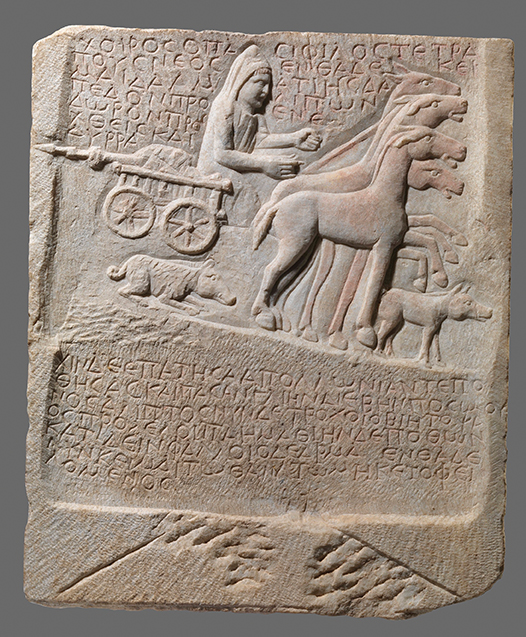
Installation view of A World of Emotions: Ancient Greece, 700 BC–200 AD, Onassis Cultural Center, New York, 2017. Photograph by Joseph Coscia Jr.
We think of the art of ancient Greece as the epitome of serene beauty and refinement, but a new exhibition at the Onassis Cultural Center in New York reveals how often deep, even combustible, feelings were expressed in the artifacts of the Hellenic civilization. A World of Emotions: Ancient Greece, 700 BC–200 AD features more than 130 masterpieces from numerous international museums, many on view in the United States for the first time, including sculptural works in marble, bronze, and clay; red and black figured pottery; and a collection of ostrakons, the ceramic shards used as ballots when voting on whether a public figure should be banished—also the source of the word ostracize. The works tell stories of profound loss, the lust and rage of the gods, the destructive powers of envy, and of the cunning politicians who used fear and hope to manipulate the people.
The gestures and poses in some sculptures and vase paintings held emotional meanings for the ancients that are not immediately clear to the modern viewer. Only when we read the translation of its inscription do we understand that a marble stele—a slab-shaped monument carved in relief—depicting a young boy dangling a toy over his playful pet dog is actually a funeral memorial to the child. Another stele commemorates a pet piglet that (the inscription informs us) was an accomplished acrobat and traveling performer. The animal met his death in what may be the world’s earliest recorded traffic fatality—trampled by a horse and wagon, which are shown in bas relief running over the hapless pig.

Funerary Stele for a Lovable Pig, Victim of a Traffic Accident, second–third century. © Hellenic Ministry of Culture and Sports–Archaeological Receipts Fund; photograph by Kostas Xenikakis.
The further into the exhibit the viewer goes, the more ominous the emotions become. There are amulets meant to cast curses showing the contorted bodies of the intended victims. Several works take the wrath of Achilles in the Trojan War as their theme. Two heads, survivors of a late classical sculptural group, portray Achilles and the Amazon warrior queen Penthesilea. The sculpture depicts the moment when, having run her through with his sword in the fury of battle, Achilles removes her helmet and instantly falls in love with Penthesilea as she takes her last breath.

Heads of Achilles and Penthesilea, Roman copies of Hellenistic originals. Antikenmuseum Basel und Sammlung Ludwig, © Antikenmuseum Basel und Sammlung Ludwig.
The exhibition closes with the darkest myth in the Greek canon: that of Medea, the spurned princess who killed her own children in her insane quest for revenge. The story is told by two exceptional vase paintings, along with a large projected photograph of opera diva Maria Callas in the role of Medea—an artifact from our time and our art that forces the viewer to ponder the power of emotion to conquer reason.
A World of Emotions: Ancient Greece, 700 BC–200 AD • Onassis Cultural Center, New York • to June 24 · onassisusa.org

